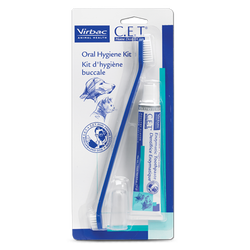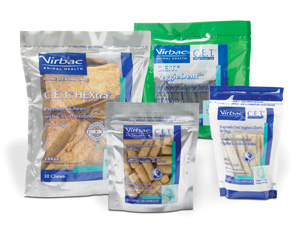Dentistry and At-Home Care
Is There a Problem?

By the age of 3 years, over 70% of cats and over 80% of dogs will have dental disease. The disease can range from inflammation and mild infection along the gum line to painful teeth that have exposed nerves or abscessed tooth roots. Many times the problem is not picked up by owners because mild halitosis (bad breath) is considered "normal" or there can be a misunderstanding of what causes the foul smell. As veterinarians and owners know, unfortunately our pets don't talk to us and tell us that there is a problem! If only they could, at least half of pets would tell us they have tenderness or discomfort before, during, and/or after eating. There are some great descriptions on the links below:
Because they can't speak, we need to monitor our pets for symptoms of dental disease like crying when chewing, anorexia, salivating excessively, pawing at the face and mouth or rubbing of the face along the floor or furniture. Some pets even develop a significant swelling along their muzzle or under an eye, which is essentially an abscess in and around the bone of an infected tooth root. But only a small fraction of cats or dogs will have such symptoms, even amongst those that have pretty severe problems. Often pets eat less or more slowly and chew with only one side of their mouth. Sometimes they compensate in a way we can't pick up on or we are not attributing to bad oral health. Many pet owners report that their pets have become picky eaters or we find at their annual appointment that they have lost weight and owners are relieved that the problem is very fixable. As a veterinarian, nothing feels better than a call from a relieved and excited owner a couple days after their pets teeth were cleaned or bad teeth extracted and they exclaim that their pet is brand new! Cats that suffer from severe inflammatory disease often seem reborn when once the problem is addressed! An appointment with our hospital to evaluate your pets teeth could change your pets quality of life for the better. We can often pinpoint those who suffer silently or let you know if your pets level of disease may be putting their kidney, heart or overall health at risk or if we can see signs of pain on oral exam.
When There is a Problem... We Can Help!
These Before and After pictures of our patient, Penelope, are a great example of responsible dental hygiene. While there is tartar buildup, only ONE tooth needed extraction! At Penelope's adult age of 7, this is ideal and partially indicates proactive owners. However, more extractions are common in adult and senior dogs. Besides age and hygiene upkeep, an animals genetics can play a role in disease progression.
|
Before Dental Surgery
|
After! Look at those pearly whites.
|
Once pets have a substantial amount of tartar and disease, it will typically need to be addressed with a thorough cleaning, polishing and possibly extractions. For this to occur in a painless, stress-free and thorough manner, this typically needs to be done under anesthesia. Many people fear anesthesia, which is understandable. However, when the right precautions are taken, dentistry can be performed very safely. Depending on the length of anesthesia and age of your pet, as well as your recommended level of care - blood work, IV or SQ fluids - and aggressive post operative pain control can be used with your pet.
|
|
Some teeth are very loose, infected, have root exposure or lesions present so they clearly need extraction. Local blocks are used to keep your pet comfortable when waking up as well as to lessen the needed anesthesia to keep your pet sleeping quietly. Radiographs are used to ensure that there is not a problem hiding under the gum line that we can't see. We always try to give the most accurate estimates possible; however, we give ranges for dentals due to the issues we can't see until the patient is under anesthesia, tartar cleaned off and underlying dental disease revealed. After the teeth are thoroughly cleaned, evaluated, polished and painful or unhealthy teeth extracted, you can do your part at home to try to prevent or slow down the development of new tartar formation and problematic disease. You can also let your pet kiss you again!
|
Now That They Are Clean, What You Can Do at Home?

Brushing, oral rinses, tartar dissolving formulas, treats and prescription foods are all options for you to use at home to slow disease formation.
Brushing: Remember first that brushing the teeth of a pet with advanced disease will only cause pain. If a dental was recommended, have your pets teeth cleaned, allow a week for healing and then start the brushing cycle. Otherwise your pet will resent brushing long term. There are a number of products both prescription and over the counter that can be used. Most times prescription products are more effective and are not that much more expensive than over-the-counter so make the right decision on product. Your efforts will be rewarded in most pets. It is best to start brushing your pets teeth from the time they are a puppy or kitten. They need to get used to you playing with their mouths from day 1, so it is not new to them and they are not afraid. If brushing is new to your mature pet, see the video in our Helpful Links section:
Brushing: Remember first that brushing the teeth of a pet with advanced disease will only cause pain. If a dental was recommended, have your pets teeth cleaned, allow a week for healing and then start the brushing cycle. Otherwise your pet will resent brushing long term. There are a number of products both prescription and over the counter that can be used. Most times prescription products are more effective and are not that much more expensive than over-the-counter so make the right decision on product. Your efforts will be rewarded in most pets. It is best to start brushing your pets teeth from the time they are a puppy or kitten. They need to get used to you playing with their mouths from day 1, so it is not new to them and they are not afraid. If brushing is new to your mature pet, see the video in our Helpful Links section:
Chews, treats, and foods:

Chews and treats are loved by most cats, dogs and owners. We love to make our pets happy! It is important to remember though, when giving chews or treats to a dog that they must chew them for the product to work. Pets who quickly swallow treats whole or only take five or six pulls on a chewie before swallowing them will not benefit from these treats. For cats with inflammatory mouth disease and few teeth, treats and foods are typically not effective because many of these cats swallow food whole or only chew with the less affected side of their mouth, leaving the other side to worsen. For pets with advanced disease, these products can cause pain! As mentioned above, a professional dental should be performed first, as well as a little healing time, prior to starting these products.

Remember too that these products have calories, especially treats. It is important to take this into account when feeding your cat or dog. Obese pets, with a fresh mouth, are still not happy pets. Typically it means just decreasing the amount of regular food you are feeding your cat or dog or switching over to a product like Science Diet T/D where the "dental treat" is their food.
Pets with allergic disease or sensitive stomachs may not tolerate any of the products in this section. Talk to us before starting your pet on these products if you have a pet with a chronically managed condition.
Pets with allergic disease or sensitive stomachs may not tolerate any of the products in this section. Talk to us before starting your pet on these products if you have a pet with a chronically managed condition.









